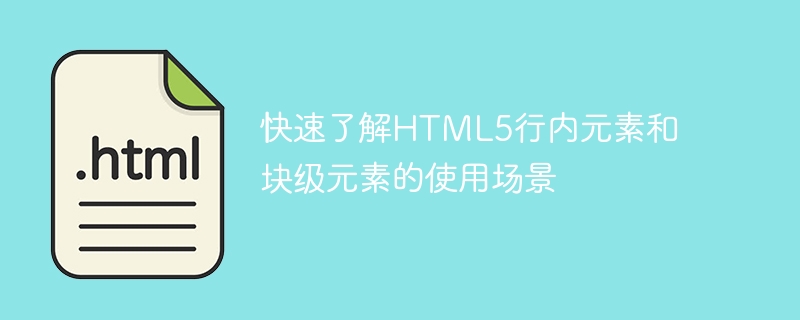Home >Web Front-end >HTML Tutorial >A quick guide to using HTML5 inline and block-level elements
A quick guide to using HTML5 inline and block-level elements
- WBOYWBOYWBOYWBOYWBOYWBOYWBOYWBOYWBOYWBOYWBOYWBOYWBOriginal
- 2023-12-28 15:04:21873browse

Quickly understand the usage scenarios of HTML5 inline elements and block-level elements, you need specific code examples
HTML5 is the standard language for web development, and rich content can be built through HTML markup language Diverse web content. In HTML5, elements are divided into two types: inline elements and block-level elements. This article will quickly introduce the usage scenarios of these two element types and give corresponding code examples.
- Inline elements
Inline elements are those elements that do not occupy a line by themselves. They appear side by side with other elements on the same line. Common inline elements include: , , , , , etc.
Inline elements are often used in the following scenarios:
1.1 Text modification: Inline elements can be used to modify the style of text, such as setting text color, font size, italics, bolding, etc. Here is a sample code:
<p>这是一段<span style="color: blue;">蓝色</span>的文字<span style="font-size: 20px;">(字号为20px)</span></p>
1.2 Links and Navigation: Links and navigation menus can be created using inline elements. Here is a sample code:
<nav> <a href="index.html">首页</a> <a href="about.html">关于</a> <a href="contact.html">联系我们</a> </nav>
1.3 Emphasis and emphasis: Inline elements can be used to emphasize and highlight specific text content. The following is a sample code:
<p>在这种情况下,<span class="highlight">强调</span>和<span class="highlight">重点</span>非常重要。</p>
<style>
.highlight {
background-color: yellow;
font-weight: bold;
}
</style>- Block-level elements
Block-level elements refer to those elements that will occupy a line alone. They will automatically wrap and start at the beginning of a new line. Start displaying. Common block-level elements include:
,
~, , - , etc.
Block-level elements are often used in the following scenarios:
2.1 Layout and hierarchy: Block-level elements are very suitable for layout and creating the hierarchical structure of the page. For example, create navigation bars, sidebars, headers, footers, etc. Here is a sample code:
<header>
<h1>网页标题</h1>
<nav>
<ul>
<li><a href="index.html">首页</a></li>
<li><a href="about.html">关于</a></li>
<li><a href="contact.html">联系我们</a></li>
</ul>
</nav>
</header>2.2 Lists and Paragraphs: Block-level elements can be used to create ordered and unordered lists, paragraphs, etc. The following is a sample code:
<p>这是一个段落。</p>
<ul>
<li>列表项1</li>
<li>列表项2</li>
<li>列表项3</li>
</ul>
2.3 Containers and decorative elements: Block-level elements can be used to create containers and decorative elements, such as boxes, dividing lines, blocks, etc. The following is a sample code:
<div class="box">
<p>这是一个盒子</p>
</div>
<hr>
<section>
<h2>区块标题</h2>
<p>这是一个区块</p>
</section>
<style>
.box {
border: 1px solid black;
padding: 10px;
}
</style>Summary: Inline elements and block-level elements each have different application scenarios. When writing HTML code, we choose to use them reasonably according to our needs to achieve better web page display effects and user experience. I hope this article can help you better understand and apply the usage scenarios of inline elements and block-level elements in HTML5.
- ,
- , etc.
Block-level elements are often used in the following scenarios:
2.1 Layout and hierarchy: Block-level elements are very suitable for layout and creating the hierarchical structure of the page. For example, create navigation bars, sidebars, headers, footers, etc. Here is a sample code:
<header> <h1>网页标题</h1> <nav> <ul> <li><a href="index.html">首页</a></li> <li><a href="about.html">关于</a></li> <li><a href="contact.html">联系我们</a></li> </ul> </nav> </header>2.2 Lists and Paragraphs: Block-level elements can be used to create ordered and unordered lists, paragraphs, etc. The following is a sample code:
<p>这是一个段落。</p> <ul> <li>列表项1</li> <li>列表项2</li> <li>列表项3</li> </ul>
2.3 Containers and decorative elements: Block-level elements can be used to create containers and decorative elements, such as boxes, dividing lines, blocks, etc. The following is a sample code:
<div class="box"> <p>这是一个盒子</p> </div> <hr> <section> <h2>区块标题</h2> <p>这是一个区块</p> </section> <style> .box { border: 1px solid black; padding: 10px; } </style>Summary: Inline elements and block-level elements each have different application scenarios. When writing HTML code, we choose to use them reasonably according to our needs to achieve better web page display effects and user experience. I hope this article can help you better understand and apply the usage scenarios of inline elements and block-level elements in HTML5.
The above is the detailed content of A quick guide to using HTML5 inline and block-level elements. For more information, please follow other related articles on the PHP Chinese website!

